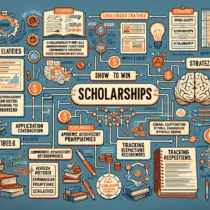Scholarship essays often represent a critical opportunity for students to stand out in a sea of applicants. Crafting a compelling and memorable scholarship essay requires a unique combination of storytelling, self-reflection, and strategic presentation of one’s achievements. Here are some methods and insights to help students create a scholarship essay that captures attention and leaves a lasting impact.
Understand the Prompt
Before putting pen to paper, it is crucial to fully understand the essay prompt. Scholarship committees design essay prompts to assess applicants’ fit with the scholarship criteria, values, and goals. Whether the prompt asks about personal achievements, experiences that shaped their life, or future aspirations, a clear comprehension of the question is the first step towards a successful essay.
Brainstorming and Outlining
Once the prompt is crystal clear, brainstorming ideas is the next step. Students should reflect on their lives, including significant events, challenges, and accomplishments that align with the topic. Creating a mind map or a list of potential points to include can help organize thoughts systematically.
An outline serves as a roadmap for the essay, ensuring that it flows logically from introduction to conclusion. A typical structure might include an engaging introduction, a few paragraphs detailing specific experiences or accomplishments, and a strong conclusion that ties everything together.
Start with a Captivating Introduction
First impressions matter, especially in writing. The introduction should grab the reader’s attention right away. Beginning with an anecdote, a powerful quote, or a thought-provoking question can intrigue the reader and set the tone for the rest of the essay. A well-crafted introduction provides a glimpse of the essay’s direction and entices the reader to continue reading.
Be Authentic and Personal
Authenticity is key in a scholarship essay. Committee members can distinguish between genuine expressions and generic statements. Sharing personal experiences, emotions, and thoughts can make the essay more relatable and engaging. It’s essential to communicate one’s true self, as authenticity fosters a stronger connection with the reader.
Highlight Achievements and Experiences
While discussing achievements is important, it’s equally crucial to show how those achievements were attained. Instead of merely listing accomplishments, students should detail the journey, challenges faced, and lessons learned. Connecting achievements to personal growth or future goals can add depth to the essay.
Demonstrate Passion and Motivation
Scholarship committees are often interested in a candidate’s passion and drive. Showing enthusiasm for one’s field of study or future career can be compelling. Discussing what motivates or inspires them, and how the scholarship will help achieve their goals, can make their essay resonate with evaluators.
Use Clear and Concise Language
Scholarship essays should be easy to read and understand. Using clear, concise language ensures that ideas are communicated effectively. Avoiding overly complex sentences or unnecessary jargon can keep the reader engaged. Each sentence should serve a purpose and contribute to the overall narrative.
Include Specific Examples
Specific examples can make abstract qualities more tangible. Rather than saying “I am a leader,” describing a specific scenario where they demonstrated leadership can be far more impactful. Concrete examples provide evidence of character traits and skills, making the essay more convincing.
Show, Don’t Just Tell
The adage “show, don’t tell” is particularly pertinent in scholarship essays. Instead of stating that they are hardworking, students should illustrate a situation that required perseverance and dedication. Using descriptive language to paint a picture helps the reader visualize experiences and understand their significance.
Revise and Proofread
After completing the initial draft, revising is necessary to refine the essay. Students should review their essay multiple times, focusing on clarity, coherence, and consistency. Seeking feedback from teachers, mentors, or peers can provide valuable insights and highlight areas that need improvement.
Proofreading is equally important to eliminate grammatical errors, typos, and stylistic inconsistencies. A polished essay reflects attention to detail and professionalism, which can positively influence the reader’s perception.
Adhere to the Guidelines
Each scholarship has specific guidelines, including word count, formatting, and submission requirements. Adhering to these guidelines is crucial, as failure to comply can result in disqualification. Carefully reading and following instructions demonstrates respect for the application process and attention to detail.
Convey Financial Need (If Applicable)
For need-based scholarships, clearly articulating financial need can be a decisive factor. Being honest and detailed about their financial situation, without exaggerating or downplaying it, helps committees understand the applicant’s context. Explaining how receiving the scholarship would alleviate financial burdens and enable educational pursuits can strengthen their application.
Highlight Community Involvement and Leadership
Many scholarships value community involvement and leadership qualities. Discussing volunteer work, participation in community projects, or leadership roles in school or extracurricular activities can illustrate a commitment to making a positive impact. Highlighting these experiences demonstrates a well-rounded character and a sense of responsibility.
Express Gratitude and Forward-Looking Vision
Concluding the essay with a note of gratitude towards the scholarship committee for their time and consideration can leave a positive impression. Additionally, outlining a forward-looking vision, detailing how the scholarship will help achieve future goals, can reinforce the purpose and aspirations behind the application.
Practice Integrity
Maintaining honesty and integrity throughout the essay is paramount. Exaggerations or falsehoods can be detrimental if discovered. Authenticity and sincerity not only build credibility but also reflect moral integrity, a quality highly valued by scholarship committees.
Stay Positive
Throughout the essay, maintaining a positive and optimistic tone can be inspiring. Even when discussing challenges or adversities, focusing on the positive outcomes and lessons learned can create a more uplifting and motivational narrative.
Tailor Each Essay
While it might be tempting to use the same essay for multiple scholarships, tailoring each essay to align with the specific values and criteria of each scholarship can make a significant difference. Customizing content signals to the committee that the applicant has invested time in understanding what the scholarship stands for and how they embody those qualities.
Success Through Storytelling
Ultimately, a successful scholarship essay is one that tells a compelling story. Weaving together experiences, achievements, aspirations, and personal reflections into a cohesive narrative can captivate the reader and convey the essence of the applicant.
Emphasizing Growth and Potential
Scholarship committees often look for candidates with potential for growth and contributions to their field or community. Describing how past experiences have prepared them for future challenges and opportunities can underline their readiness to take on new endeavors and make meaningful contributions.
A Final Thought
Crafting a scholarship essay that stands out requires thoughtful preparation, self-reflection, and meticulous attention to detail. By understanding the prompt, being authentic, using clear language, and illustrating experiences with specific examples, students can create a compelling narrative that resonates with scholarship committees. Staying true to one’s unique journey, goals, and motivations will make the essay not only stand out but also truly shine.






